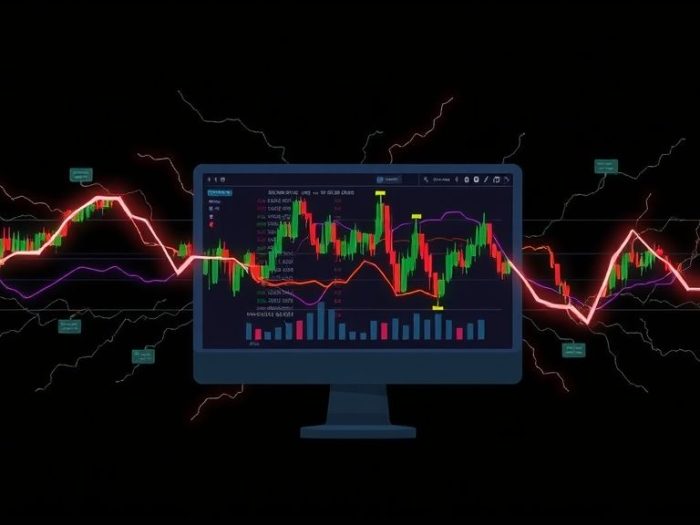High-Frequency Trading (HFT) is a type of algorithmic trading characterized by extremely high speeds
and short-term trading horizons. While true HFT is typically the domain of large institutions, some
of its underlying techniques can be adapted for retail traders. This article explores HFT concepts
and how they can be applied to improve trading strategies for individual investors.
Understanding High-Frequency Trading (HFT)
High-Frequency Trading (HFT) involves using powerful computers and algorithms to execute a large
number of orders in fractions of a second. HFT firms often profit from tiny price discrepancies
and short-term market inefficiencies.
Why HFT Techniques Need Adaptation for Retail Traders
Retail traders typically don’t have access to the same technology and infrastructure as HFT firms.
Therefore, directly replicating HFT strategies is usually impossible. However, the underlying
principles can be adapted.
HFT Concepts and How to Adapt Them
1. Speed and Latency
HFT relies heavily on speed. Retail traders can’t compete with HFT firms in this area.
- HFT: Trades are executed in milliseconds.
- Retail Adaptation: Focus on strategies that don’t require ultra-fast execution, such as swing trading or position trading.
2. Order Types
HFT uses advanced order types.
- HFT: Uses complex algorithms and order types (e.g., iceberg orders) to manipulate the market.
- Retail Adaptation: Focus on mastering basic order types like limit orders and stop-loss orders.
3. Statistical Arbitrage
HFT exploits statistical relationships between assets.
- HFT: Uses complex statistical models and high-speed data feeds.
- Retail Adaptation: Adapt by focusing on simpler mean reversion strategies using technical indicators.
4. Market Making
HFT firms provide liquidity to the market.
- HFT: Places buy and sell orders simultaneously to profit from the bid-ask spread.
- Retail Adaptation: Not directly applicable to retail traders.
5. Event-Driven Trading
HFT algorithms react to news and events.
- HFT: Uses natural language processing (NLP) to analyze news and social media in real-time.
- Retail Adaptation: Adapt by incorporating news analysis into your fundamental and technical analysis.
Adapted Strategies for Retail Traders
Here are some ways retail traders can adapt HFT concepts:
1. Momentum Trading
HFT exploits short-term momentum. Retail traders can adapt this by using momentum indicators on
higher timeframes (e.g., hourly or daily charts) to identify sustained trends.
2. Mean Reversion Strategies
HFT uses statistical arbitrage. Retail traders can use simpler mean reversion strategies with
oscillators like the RSI (Relative Strength Index) or Stochastic Oscillator.
3. Order Flow Analysis (Simplified)
HFT analyzes order flow. Retail traders can adapt this by observing volume and price action at
key support and resistance levels.
4. Algorithmic Alerts
While not full automation, retail traders can use platforms that provide alerts based on
algorithmic analysis.
Important Considerations
- Realistic Expectations: Don’t expect to replicate HFT profits with retail technology.
- Risk Management: Strict risk management is essential.
- Backtesting: Thoroughly backtest your strategies.
- Platform Limitations: Be aware of the limitations of your trading platform.
Conclusion
While retail traders can’t compete with the speed and sophistication of HFT, they can adapt some
of its underlying principles. Focusing on momentum trading, mean reversion, and order flow analysis,
while prioritizing risk management, can enhance your trading strategies.
Related Keywords
High-frequency trading, HFT, algorithmic trading, automated trading, trading algorithms,
quantitative trading, trading strategies, forex trading, stock trading, financial markets.
Frequently Asked Questions (FAQ)
1. What is High-Frequency Trading (HFT)?
High-Frequency Trading (HFT) is a type of algorithmic trading that uses powerful
computers and algorithms to execute a large number of orders at extremely high speeds.
2. Why can’t retail traders directly replicate HFT strategies?
Retail traders typically don’t have access to the same level of technology and
infrastructure as HFT firms, making it difficult to compete on speed.
3. What are some HFT concepts that can be adapted for retail trading?
HFT concepts that can be adapted include momentum trading, mean reversion
strategies, and order flow analysis (in a simplified form).
4. How is momentum trading adapted from HFT for retail traders?
Retail traders can use momentum indicators on higher timeframes to identify
sustained trends, rather than trying to exploit very short-term momentum like HFT.
5. What is mean reversion and how is it adapted from HFT?
HFT uses statistical arbitrage to exploit price discrepancies. Retail traders can
use simpler mean reversion strategies with oscillators like RSI or Stochastic.
6. How is order flow analysis adapted for retail traders?
Retail traders can observe volume and price action at key support and resistance
levels to get a simplified sense of order flow.
7. What are algorithmic alerts?
Algorithmic alerts are notifications provided by some platforms based on
algorithmic analysis of market data, which can help retail traders identify potential
trading opportunities.
8. What are the key limitations of adapting HFT techniques for retail trading?
The key limitation is that retail traders cannot compete with the speed and
sophistication of HFT infrastructure.
9. Is algorithmic trading a guaranteed way to make profits?
No, algorithmic trading is not a guaranteed way to make profits. It involves
risks, and careful strategy development and risk management are essential.
10. What is the most important factor to consider when using any algorithmic trading strategy?
Strict risk management is paramount. Always use stop-loss orders and manage your
position size to protect your capital.



